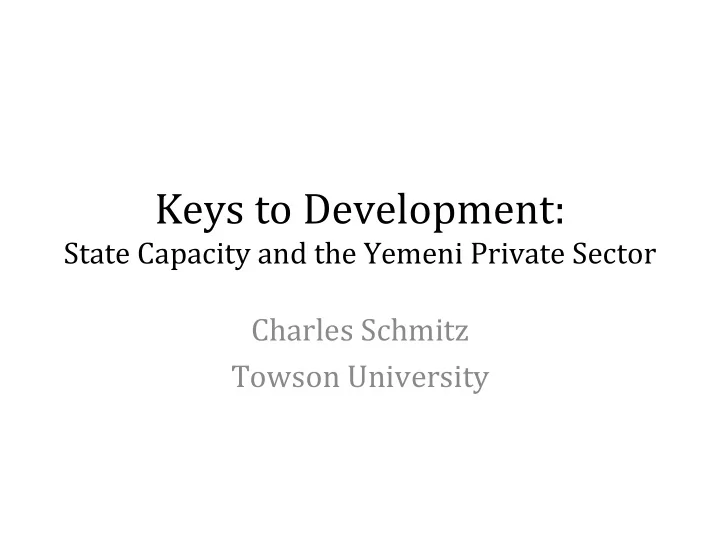

Keys to Development: State Capacity and the Yemeni Private Sector Charles Schmitz Towson University
Yemen in Context • Substantial achievements over the last forty years • Per capita income, health, education, physical infrastructure have all been transformed • By whatever time period, 10, 20, 30 years, Yemen has grown and livelihoods have improved – In spite extremely high rates of population growth
Source: Poverty Survey
Remittances and Oil • Growth driven by two factors: remittances and oil • Remittances remained steady at about 1.5 billion USD while the Yemeni economy grew reducing the significance of remittances • Oil growth begins in 1990’s but increases dramatically in the 2000’s
Oil Curse • Agriculture declines, services grow – Transportation, commerce, communications (non‐commodity sectors) – Ag 10% of GDP, 30% of labor • Yemen imports most of its staples – wheat and rice • 90% of water use in agriculture, some 40% of that water is used in Qat • Qat is 3% of GDP
A word on agriculture • Yemen very low per capita water resources • Green by Arabian standards – Low bar • Only 3% arable dependent upon rains – Half of Yemen agricultural land rain fed only • “Virtual” water concepts suggests that Yemen import water intensive crops and export products that use relatively little water
State Dependence • State revenues dependent upon oil – 75% of revenues from oil over the last 15 years • State bureaucracy atrophied, particularly tax collection – State became a distribution network of oil revenues • State revenue not dependent upon growth of the economy outside of oil
Oil Declining • Yemeni oil peaked in 2001 • Rising prices masked decline in production • Decline now affecting economy • Current account deficits • Declining Foreign Reserves
Yemen not highly indebted • About 20% of GDP, relatively low by world standards • Most aid from multilateral agencies • US a small actor in Yemeni aid • Saudi contribution underrepresented by official figures
Short Term Crisis • Oil production stopped • Regime running down foreign reserves • Prime Minister reportedly in Saudi Arabia looking to cover state salaries • Currency losing value, potential collapse of Rial • Rapid inflation • Food imports threatened
Medium Term Transition • Growth not dependent upon natural resources • More diverse economy, an asset in the long run – Oil and Gas – Aden Port – Free trade zone – Import substitution industry – Labor export – Tourism
State Capacity • Diverse economy dependent upon state capacity – Coordination of coherent national investment strategy – Dynamic comparative advantage – Social and physical infrastructure – Development of Yemeni private sector – National pact • Foreign investment looks for growth, does not cause growth. • Institutional capacity and credible politics – State not “free” of politics – Social Pact
Recommend
More recommend